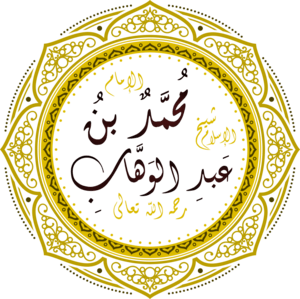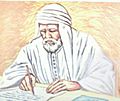Muhammad ibn Abd al-Wahhab facts for kids
Quick facts for kids Muḥammad bin ʿAbd al-Wahhāb bin Sulaimān bin ʿAlī bin Muḥammad bin Aḥmad at-Tamīmī |
|
|---|---|

Muḥammad ibn ‘Abd al-Wahhāb's name in Islāmic calligraphy
|
|
| Religion | Islām |
| Denomination | Sunni |
| Personal | |
| Born | 1703 (1115 A.H) Al-‘Uyainah, Najd |
| Died | 22 June 1792 (1206 AH) (aged 88-89) Dir‘iyah, First Saudi State |
| Children |
List
‘Alī (first)
Ḥasan Ḥusain Ibrāhīm ‘Abd Allāh ‘Alī (second) Fāṭimah ‘Abd al-‘Azīz |
| Senior posting | |
| Title | Sheikh Al-Islam |
| Influenced | Muhammad bin Saud, House of Saud ‘Abd al-‘Azīz ibn ‘Abd Allāh ibn Bāz, Muḥammad ibn al-‘Uthaimīn, Muḥammad Nāṣir ad-Dīn al-Albānī, ‘Abd ar-Raḥmān as-Sudais, Su‘ūd ash-Shuraim |
| Arabic name | |
| Personal (Ism) | Muḥammad |
| Patronymic (Nasab) | ibn ‘Abd al-Wahhāb ibn Sulaimān ibn ‘Alī ibn Muḥammad ibn Aḥmad ibn Rāshid |
| Teknonymic (Kunya) | Abū al-Ḥasan |
| Epithet (Laqab) | an-Najdī |
| Toponymic (Nisba) | at-Tamīmī |
Muḥammad ibn ‘Abd al-Wahhāb (1703 – 22 June 1792) was an important religious leader and scholar from Najd in central Arabia. He is known for starting a movement that aimed to bring Muslims back to what he believed were the original teachings of Islam. This movement is often called Wahhabism, though his followers prefer the term Salafiyya.
The name "Wahhabi" was actually given by his critics. Muhammad ibn ‘Abd al-Wahhab came from a family of jurists, who are experts in Islamic law. He learned about Islamic law from a young age. He believed Muslims should follow the Quran and Hadith (sayings and actions of Prophet Muhammad) very closely. He thought that everyone, both male and female, should read and study the Quran for themselves. He also believed in using `ijtihad`, which means using independent thinking to understand religious texts, instead of just `taqlid` (blindly following past interpretations).
He was against some popular religious practices, like visiting and honoring the tombs of Muslim saints. He felt these practices were new additions to Islam or even a form of idolatry, which means worshipping something other than God. His main idea for changing society was based on `Tawhid`, the belief in the absolute oneness of God.
Even though many scholars, including his own father and brother, disagreed with his ideas, Muhammad ibn ‘Abd al-Wahhab made an important agreement with Muhammad bin Saud. This agreement helped establish the Emirate of Diriyah, which was the first Saudi state. This partnership between their families continues to this day in Saudi Arabia. His descendants, the Al ash-Sheikh family, are still very important religious leaders in Saudi Arabia.
Contents
Early Life and Studies
Muhammad ibn ‘Abd al-Wahhab was born in 1703 in a village called ‘Uyayna, in the Najd region of central Arabia. His family was well-known for their knowledge of Islamic law. His father was a legal expert, and his grandfather was a judge.
He started his education with his father, learning the Quran by heart. He also studied basic Islamic law and beliefs. He noticed that many people in his area honored Muslim saints and believed they could perform miracles. He felt these practices were not part of the original Islam. This made him want to travel and learn more.
He left ‘Uyayna and went to Mecca for the Greater Pilgrimage. After that, he traveled to Medina, which was a very important stop for him. In Medina, he met scholars who influenced his thinking, especially a Hanbali theologian named ‘Abd Allāh b. Ibrāhīm al-Najdī. He also met Mohammad Hayya Al-Sindhi, who taught him to reject popular religious practices related to saints and their tombs. After his studies in Medina, he traveled to Basra, which was a center of Islamic culture.
Early Preaching and Reforms
When Muhammad ibn ‘Abd al-Wahhab returned home, he started gaining followers. One of them was Uthman ibn Mu'ammar, the ruler of ‘Uyayna. They made an agreement: Muhammad ibn ‘Abd al-Wahhab would support Ibn Mu'ammar's political goals, and in return, Ibn Mu'ammar would support his religious teachings.
Muhammad ibn ‘Abd al-Wahhab then began to put his ideas into practice. He convinced Ibn Mu'ammar to help him level the grave of Zayd ibn al-Khattab, a companion of Prophet Muhammad, because locals were honoring it. He also ordered the cutting down of trees that people considered sacred, even cutting one down himself.
These actions caught the attention of Sulaiman ibn Muhammad ibn Ghurayr, a powerful chief from another region. He threatened Ibn Mu'ammar, saying he would lose money if he didn't get rid of Muhammad ibn ‘Abd al-Wahhab. So, Ibn Mu'ammar had to ask Muhammad ibn ‘Abd al-Wahhab to leave.
Forming the Saudi State
The Agreement with Muhammad bin Saud
After leaving ‘Uyayna, Muhammad ibn ‘Abd al-Wahhab was invited to Diriyah by its ruler, Muhammad bin Saud. In 1744, they made a very important agreement. They decided to work together to bring the people of the Arabian Peninsula back to what they believed were the true principles of Islam.
Muhammad bin Saud promised to protect Muhammad ibn ‘Abd al-Wahhab and his mission. In return, Muhammad ibn ‘Abd al-Wahhab agreed that Muhammad bin Saud would be the political and military leader, while he would guide religious matters. This agreement was a promise of loyalty between them. It created a partnership between the Al Saud family (Muhammad bin Saud's family) and the Al ash-Sheikh family (Muhammad ibn ‘Abd al-Wahhab's descendants). This partnership has lasted for almost 300 years and was the driving force behind the expansion of the Saudi state.
The First Saudi State
The 1744 agreement between Muhammad bin Saud and Muhammad ibn ‘Abd al-Wahhab led to the creation of the first Saudi state, known as the Emirate of Diriyah. This alliance gave the Al Saud family a clear religious purpose for their expansion. Their forces conquered the Najd region and spread their influence across much of what is now Saudi Arabia. They aimed to remove practices they saw as polytheism and spread Muhammad ibn ‘Abd al-Wahhab's teachings.
Family and Legacy
Muhammad ibn ‘Abd al-Wahhab had six sons. Four of his sons, Hussain, Abdullah, Ali, and Ibrahim, started religious schools near their home in Diriyah. They taught students from different parts of Arabia.
His descendants, known as the Al ash-Sheikh family, have always been important religious leaders in Saudi Arabia. They are highly respected, similar to the Saudi royal family, and share power with them. The Al ash-Sheikh family guides religious matters and supports the Al Saud family's political rule. In return, the Al Saud family upholds and spreads the teachings of Muhammad ibn ‘Abd al-Wahhab.
His Teachings
Muhammad ibn ‘Abd al-Wahhab believed his movement was about purifying Islam. He wanted Muslims to return to what he saw as the religion's original principles. His writings were usually short and filled with quotes from the Quran and Hadith. His most famous book is Kitab al-Tawhid (The Book of the Oneness of God).
He taught that the most important idea in Islam is `Tawhid`, the belief in the uniqueness and oneness of God. He strongly spoke out against `shirk`, which he defined as associating partners with God.
In Kitab al-Tawhid, he explained that worship in Islam includes prayers, fasting, and asking for help or protection only from Allah. He emphasized that asking for help, protection, or intercession from anyone or anything other than Allah is `shirk` and goes against `Tawhid`. He believed that those who did this would not be forgiven.
He had a strong view that simply saying the testimony of faith was not enough to be a Muslim if a person believed there could be intercessors with God. He saw this as `shirk`. This was a major difference between him and many others.
His movement is often called Wahhabism. However, many followers prefer the term Salafism. The name "Wahhabism" comes from his father's name, 'Abd al-Wahhab. Scholars note that Salafism is a broader term for puritanical Islam, while Wahhabism refers specifically to the stricter Saudi school.
On Sufism
Muhammad ibn ‘Abd al-Wahhab recognized the value of `Tasawwuf` (Sufism), which focuses on purifying one's inner self. He called it "the science of the deeds of the heart." He believed it was an important part of religious studies, as long as people followed the rules of Islamic law. His son, ‘Abd Allah, also spoke positively about purifying the inner self.
On Other Religions
Muhammad ibn ‘Abd al-Wahhab believed that followers of Christianity and Judaism had changed their religions over time. He warned Muslims not to copy practices he saw as wrong, such as turning the graves of prophets into places of worship. He believed his mission was to restore a purer form of Islam. However, some scholars say he never called for the destruction or death of people from other religious groups. He believed they would be judged in the afterlife.
On Saints
Muhammad ibn ‘Abd al-Wahhab strongly condemned the worship of saints, calling it `shirk`. He believed it was wrong to give divine qualities to anyone other than God. However, he did not deny that saints existed or that they could perform miracles by God's grace during their lives. He just opposed the idea of worshipping them or seeking their help after their death.
Modern Recognition
The national mosque of Qatar is named after him, called the "Imam Muhammad ibn Abd al-Wahhab Mosque". It opened in 2011 and can hold 30,000 people.
The Saudi government has also developed Diriyah, Muhammad ibn ‘Abd al-Wahhab's home area, into a major tourist attraction. There is also a foundation named after him, which plans to include a presentation near his mosque.
Works
- Risālah Aslu Dīn Al-Islām wa Qā'idatuhu
- Kitab al-Quran (The book of Allah)
- Kitab at-Tawhid (The Book of the Oneness of God)
- Kashf ush-Shubuhaat (Clarification of the Doubts)
- Al-Usool-uth-Thalaatha (The Three Fundamental Principles)
- Al Qawaaid Al 'Arbaa (The Four Foundations)
- Al-Usool us Sittah (The Six Fundamental Principles)
- Nawaaqid al Islaam (Nullifiers of Islam)
- Adab al-Mashy Ila as-Salaa (Manners of Walking to the Prayer)
- Usul al-Iman (Foundations of Faith)
- Fada'il al-Islam (Excellent Virtues of Islam)
- Fada'il al-Qur'an (Excellent Virtues of the Qur'an)
- Majmu'a al-Hadith 'Ala Abwab al-Fiqh (Compendium of the Hadith on the Main Topics of the Fiqh)
- Mukhtasar al-Iman (Abridgement of the Faith; i.e. the summarised version of a work on Faith)
- Mukhtasar al-Insaf wa'l-Sharh al-Kabir (Abridgement of the Equity and the Great Explanation)
- Mukhtasar Seerat ar-Rasul (Summarised Biography of the Prophet)
- Kitaabu l-Kabaair (The Book of Great Sins)
- Kitabu l-Imaan (The Book of Trust)
- Al-Radd 'ala al-Rafida (The Refutation of the Rejectionists)
Images for kids
-
An 18th century map of the Arabian Peninsula (circa 1740s)
See also
 In Spanish: Muhámmad ibn Abd-al-Wahhab para niños
In Spanish: Muhámmad ibn Abd-al-Wahhab para niños








